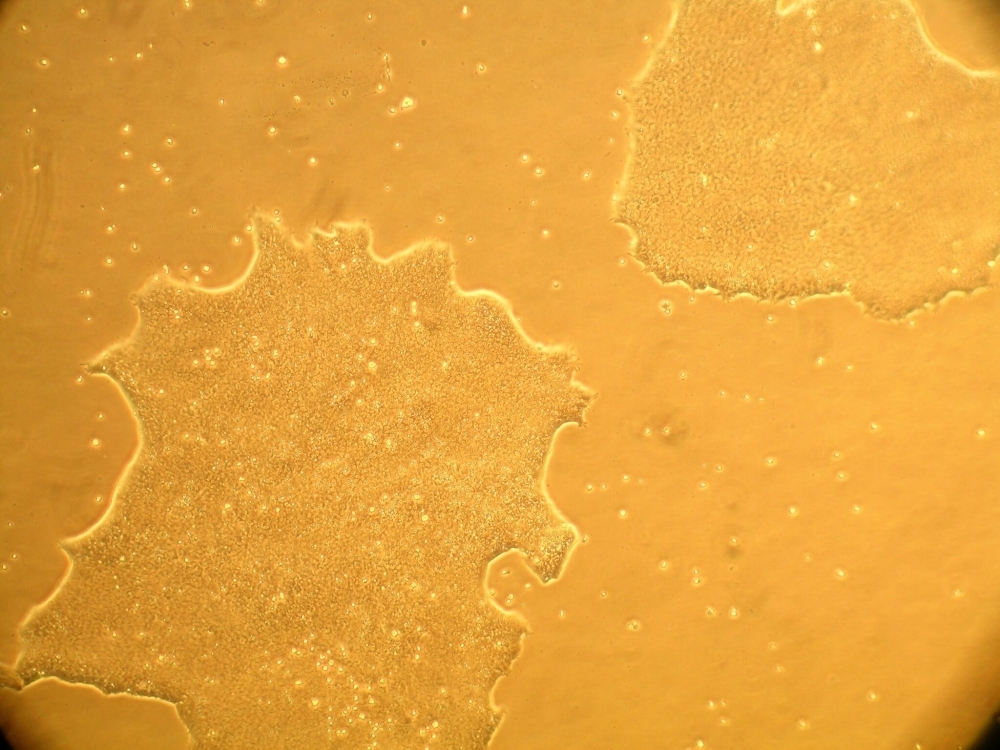

Article published in Stem Cell Research by researchers at the National Embryonic Stem Cell Laboratory warn of the importance of routine monitoring to avoid misidentification and cross-contamination (image: colony of human-induced pluripotent stem cells / LaNCE)
Article published in Stem Cell Research by researchers at the National Embryonic Stem Cell Laboratory warn of the importance of routine monitoring to avoid misidentification and cross-contamination.
Article published in Stem Cell Research by researchers at the National Embryonic Stem Cell Laboratory warn of the importance of routine monitoring to avoid misidentification and cross-contamination.

Article published in Stem Cell Research by researchers at the National Embryonic Stem Cell Laboratory warn of the importance of routine monitoring to avoid misidentification and cross-contamination (image: colony of human-induced pluripotent stem cells / LaNCE)
By Karina Toledo | Agência FAPESP – Advances in techniques to transform human adult cells into induced pluripotent stem cells (hiPSCs) have led to the creation of large collections of cell lines, which hold genetic material from thousands of individuals and are often shared among different research groups.
The importance of having laboratories implement routine monitoring to confirm the identity of each cell line and detect any cases of misidentification or cross-contamination is the focus for an article published in the journal Stem Cell Research by scientists who are affiliated with the University of São Paulo (USP) in Brazil and working at the National Embryonic Stem Cell Laboratory (LaNCE).
“After analyzing several commercially available monitoring methods, we showed that by analyzing markers called short tandem repeats (STRs), it’s possible to create a sort of bar code that corresponds to a distinctive genetic profile for every individual using simple inexpensive equipment,” said Lygia da Veiga Pereira, head of LaNCE and a researcher at the Center for Cell-Based Therapy (CTC), one of the Research, Innovation and Dissemination Centers (RIDCs) funded by FAPESP.
In 2016, the LaNCE team began developing a collection of hiPSCs designed to reflect the genetic makeup of the Brazilian population. The lines are generated from blood samples donated by participants in the Brazilian Longitudinal Study of Adult Health (ELSA-Brasil), a multicenter study that has been in progress since 2008 at six universities in different states around the country and is tracking 15,105 men and women aged 35-74 (read more at agencia.fapesp.br/24304).
“We have deep-frozen material from 2,000 participants, and to date, we’ve created hiPSC lines from 60 individuals in this group,” Pereira said.
The LaNCE team deployed the method for which Shinya Yamanaka of Kyoto University in Japan was awarded the 2012 Nobel Prize in Medicine. Using the technique described in 2006 by Yamanaka, the LaNCE team inserted certain genomic reprogramming proteins into peripheral blood cells from ELSA volunteers.
These proteins, called transcription factors, activate genes associated with embryonic-stage cells and switch off other genes that should be active after maturation, creating induced pluripotent stem cells that potentially differentiate into all tissue types in the human body in response to appropriate stimuli.
“We have cells from some 200 people with high blood pressure. Some respond well to treatment, while others are resistant. One of our goals is to use the cell lines created to study the variable responses of patients to hypertension medication,” Pereira said.
The use of hiPSCs in disease modeling and drug discovery has proven highly promising. However, this kind of research involves manipulating cells from many individuals at the same time, increasing the probability of cross-contamination.
Data in the scientific literature show that identification errors affect at least 15% of cell lines analyzed, casting doubt on the validity of a significant proportion of scientific findings.
According to Pereira, cell identity monitoring methods are routine in large public cell repositories but are rarely used by university and research center labs.
“When we began building our collection, we were concerned about including this monitoring as part of our quality control system,” she recalled. “So, we decided to study the available options and see which one was best in terms of feasibility and cost.”
The more sophisticated monitoring platforms can analyze about a million molecular markers, such as single-nucleotide polymorphisms (SNPs), providing a comprehensive and detailed genetic profile of the cell sample.
“The drawback of such methods is that they’re costly,” Pereira said. “In addition, you have to send the sample away to be analyzed elsewhere. So, we decided to test methods that are older and simpler.”
Among the options evaluated, the group chose STR profiling, the method used in most DNA testing worldwide. The equipment required is relatively easy to find in molecular biology facilities: a PCR array and a DNA sequencer. The cost is about US$50 per cell line, which in Pereira’s view is affordable.
“The method lets you create a sort of bar code from 15 markers that form a specific profile for each individual,” Pereira explained. “You compare the cell line profile with the DNA profile of the donor’s blood sample to see if they match. The idea is to do this kind of check from time to time.”
During the analysis that gave rise to the recently published article, the LaNCE team detected two cases of misidentified cell lines.
“The creation of this bar code will enable other research groups to check cell identity quite frequently – if we decide to share our material with partners,” Pereira said.
The article “Monitoring cell line identity in collections of human induced pluripotent stem cells” (doi: 10.1016/j.scr.2018.01.030) by Raquel Sarafian, Mariana Morato-Marques, Juliana Borsoi and Lygia Veiga Pereira can be read at sciencedirect.com/science/article/pii/S1873506118300369.
Republish
The Agency FAPESP licenses news via Creative Commons (CC-BY-NC-ND) so that they can be republished free of charge and in a simple way by other digital or printed vehicles. Agência FAPESP must be credited as the source of the content being republished and the name of the reporter (if any) must be attributed. Using the HMTL button below allows compliance with these rules, detailed in Digital Republishing Policy FAPESP.





